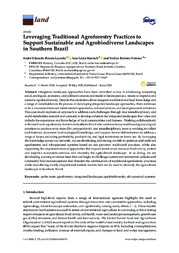Leveraging traditional agroforestry practices to support sustainable and agrobiodiverse landscapes in Southern Brazil.
Leveraging traditional agroforestry practices to support sustainable and agrobiodiverse landscapes in Southern Brazil.
Author(s): LACERDA, A. E. B. de; HANISCH, A. L.; NIMMO, E. R.
Summary: Integrated landscape approaches have been identified as key to addressing competing social, ecological, economic, and political contexts and needs in landscapes as a means to improve and preserve agrobiodiversity. Despite the consistent calls to integrate traditional and local knowledge and a range of stakeholders in the process of developing integrated landscape approaches, there continues to be a disconnect between international agreements, national policies, and local grassroots initiatives. This case study explores an approach to address such challenges through true transdisciplinary and multi-stakeholder research and outreach to develop solutions for integrated landscapes that value and include the experience and knowledge of local communities and farmers. Working collaboratively with small-scale agroforestry farmers in Southern Brazil who continue to use traditional agroecological practices to produce erva-mate (Ilex paraguariensis), our transdisciplinary team is working to collect oral histories, document local ecological knowledge, and support farmer-led initiatives to address a range of issues, including profitability, productivity, and legal restrictions on forest use. By leveraging the knowledge across our network, we are developing and testing models to optimize and scale-out agroforestry and silvopastoral systems based on our partners? traditional practices, while also supporting the implementation of approaches that expand forest cover, increase biodiversity, protect and improve ecosystem services, and diversify the agricultural landscape. In so doing, we are developing a strong evidence base that can begin to challenge current environmental policies and commonly held misconceptions that threaten the continuation of traditional agroforestry practices, while also offering locally adapted and realistic models that can be used to diversify the agricultural landscape in Southern Brazil.
Publication year: 2020
Types of publication: Journal article
Unit: Embrapa Forestry
Observation
Some of Embrapa's publications are published as ePub files. To read them, use or download one of the following free software options to your computer or mobile device. Android: Google Play Books; IOS: iBooks; Windows and Linux: Calibre.
Access other publications
Access the Agricultural Research Database (BDPA) to consult Embrapa's full library collection and records.
Visit Embrapa Bookstore to purchase books and other publications sold by Embrapa.

